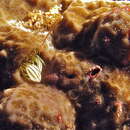Brief Summary
provided by EOL authors
The tiny hermit crabs in the genus Paguritta (on the order of 1 cm in length, excluding antennae and chelae, or "claws") are very distinct from other hermit crabs both morphologically and ecologically. In contrast to most hermit crabs, which are "free-living" (moving about in adopted shells), Paguritta species typically live in the tubes of polychaete annelid worms associated with corals or in self-created boreholes in living coral. Among other features setting these crabs apart from nearly all other hermit crabs, feathered (second) antennae are a distinctive adaptation to this sessile (i.e., stationary) mode of life, enabling the crab to capture plankton carried by the water (view videos under Media tab). The mode of filter feeding depends on the speed of water current: with low flow, the antennae are continuously moved back and forth; with higher flow, they are held perpendicular to the current, forming a sieve (Schuhmacher 1977 for more details). Most of the seven described Paguritta species are extremely similar morphologically (in fact, most of them were not recognized as distinct until 1993, having been lumped together as P. harmsi for decades, and the seventh known species in this group was not recognized until 1996). The complex taxonomic and nomenclatural history of the species in this genus was reviewed by McLaughlin and Lemaitre (1993). McLaughlin and Lemaitre recognized six species, as indicated below, and included a dichotomous key to identify them: (1) P. harmsi (described in 1939 and according to McLaughlin and Lemaitre known only from Christmas Island in the Indian Ocean) (2) P. gracilipes (formerly recognized as distinct, then synonymized with P. harmsi, but restored by McLaughlin and Lemaitre; thought by the authors to be known from Japan, the Philippines, and Vietnam, but see discussion of P. vittata, below) (3) P. morgani (new species, known from the Philippines, Papua New Guinea, and possibly Japan in serpulid polychaete tubes) (4) P. scottae (new species known only from the Maldives, in the Indian Ocean, from Porites corals) (5) P. kroppi (new species, known from the southern Marianas, including Guam, from worm holes in coral) (6) P. corallicola (described in 1978, found in the Australian Great Barrier Reef in boreholes in coral) was also discussed and distinguished by McLaughlin and Lemaitre. A 7th Paguritta species, P. vittata, was described in 1996 by Komai and Nishi. This species was apparently confused with P. gracilipes by McLaughlin and Lemaitre (1993). Paguritta gracilipes is apparently restricted to the Ogasawara (=Bonin) Islands whereas P. vittata is known from southern Japan northward to the Kii Peninsula, Ryukyu Archipelago, the Philippines, and Vietnam (but not from the Ogasawara Islands), from the subtidal to 10 m. Komai and Nishi modified the key in McLaughlin and Lemaitre (1993) to include P. vittata. Paguritta vittata usually lives in calcareous tubes of the serpulid polychaete worm Spirobranchus sp. or rarely other sepulids or shells of the vermetid snail Dendropoma sp., which Komai and Nishi found were usually associated with living massive or plate-like Porites corals.

